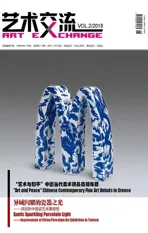景德镇:薪火传承的千年瓷都
2018-09-20颜森YANSen
文颜森 YAN Sen
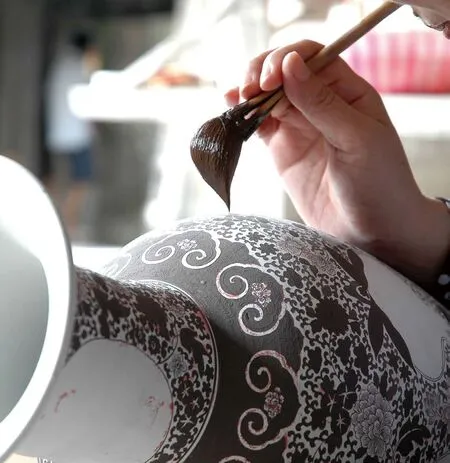
传统青花瓷制作技艺巧手 许建华摄Traditional blue-and-white porcelain Craftsmanship.Xu Jianhua/Photo
“千年瓷都”景德镇群山环抱,气候温和湿润。这里因有优质的瓷器制作原料高岭土,有丰富的瓷器烧造材料松柴,有便利的水路交通和众多的能工巧匠,是一座拥有2000年冶陶史、1000年御窑史的江南小镇。景德镇原名“新平镇”“昌南镇”,宋代景德元年(公元1004年)因出产光致茂美的瓷器,深得宋真宗赵恒赏识,一纸敕令被赐名为“景德镇”。千百年来,景德镇瓷器以“青花瓷”“玲珑瓷”“粉彩瓷”“颜色釉瓷”四大名瓷威振四方,以“白如玉、明如镜、薄如纸、声如磬”四大特色而闻名天下。
深厚的文化底蕴
追溯陶瓷史,早在新石器时代,景德镇境内的制陶活动即已开始。根据考古发现,远在商周时期,景德镇浮梁县区域,就有商周时期的陶器遗物,陶器的种类也有夹砂陶、红陶等,装饰纹样有麦穗、稻谷、回纹、云纹等,为景德镇陶瓷文化的发端之源奠定了夯实的基础。中晚唐及五代的青白瓷、宋代的影青、元时的青花、明朝的斗彩五彩、大清的珐琅彩粉彩、民国时期的浅绛彩,以及新中国成立后的陶瓷发展前所未有的繁荣,书写了景德镇的辉煌历程。蒋祁的《陶记》、朱琰的《陶说》、唐英的《陶冶图说》、蓝浦的《景德镇陶录》以及龚鉽的《景德镇陶歌》等陶瓷名著,都真实记载景德镇古代陶瓷历史及其成就,凝聚着景德镇生态及陶瓷文化的丰富内涵。
景德镇蕴藏着中华最灿烂辉煌的瓷业历史遗存, 20世纪50年代以来,在景德镇市区东部方圆30平方公里的范围内,已经发掘出五代至明清的50多处150多个古瓷窑遗址。前几年又在乐平南窑发现唐朝中期生产的瓷器。景德镇古瓷窑遗址规模之大,范围之广,密度之高,时间跨度之长,古瓷文物之丰富,在世界上都是绝无仅有的,具有极高的历史地位和学术价值。它们是景德镇陶瓷历史文化的丰厚宝库,更是景德镇成为举世瞩目的千年瓷都的坚实基础。
宝贵的世界惟一
景德镇作为“千年瓷都”,以一个产业支撑一座城市达千余年之久,是全世界仅有的。它的文化价值,可概括为两个“世界独一无二”:一是景德镇地面和地下至今保存着的大量的瓷器,其数量之大与质量之精,在全世界独一无二。历史上的景德镇,是官窑瓷和御窑瓷产瓷区。瓷器是泥做火烧而成,用柴火烧瓷,再好的把桩师傅,出窑成品率也只有20%到50%。因此,为皇帝烧瓷器一次要烧十件甚至更多,希望总会烧成一件送进皇宫。而烧成的次品,是不能流到民间的,只能就地打碎。打碎还有规矩,先用锐器在底部戳个洞,然后用钝器敲碎。从明初到清代层层堆起来,这些堆积是和当时的生产场地连在一起的,逐渐埋藏在古镇的地下,非常壮观。第二个“独一无二”则是景德镇仍保留着完整的瓷器生产工艺体系、原料、燃料供应体系和瓷器销售体系,以及与此相应的大量的古窑址、古作坊、古街巷、古建筑、古店铺、古民居、古衙门、古码头等遗存,在全世界也是独一无二。两大“独一无二”,让景德镇成为了世界极其宝贵的文化遗产宝库之一。
牢固的习俗传统
1000多年的发展历程中,景德镇自发地形成了独特而丰富的陶瓷产业习俗文化。它包括着生产习俗、行帮习俗、节日习俗语言习俗和瓷业崇拜、劳动组合、工资分配和管理方式。如行帮习俗的放排、打派头、砍草鞋、挂扁担、踩厂等;节日习俗中的腊月二十四小年送灶神、三十大年守岁、元宵闹花灯、中秋烧太平窑等;语言习俗中的三踩两响、试照子、收兜脚、射火、分水、伕、浅、件等;瓷业崇拜中的建庙祭祀瓷业英雄赵概、童宾、蒋知四、郑子木……千百年中,一直在古镇制瓷行业中流行。这些独特的习俗根深蒂固、代代相传、流传至今,仍在左右着景德镇市民的生产和生活,深深地影响着古镇的发展。
景德镇作为陶瓷产业的集散地,制瓷作坊文化,成为最具有景德镇特色的文化。自古以来,景德镇瓷器作坊成龙配套、别具一格。作坊一般由廒间、内院、泥房、正间组成。其制瓷工艺的布置,也是完全根据手工瓷业生产的实际需要而定。作坊设计非常科学,它把工艺要求和景德镇气候特点很好地结合起来:正间坐北朝南,有较长时间的日照,受惠于东南季风,使晒架塘上木架上的成坯能有最充足的干燥条件。坯架下面是贮存雨水的小池塘,揉和泥料等生产用水就取之塘中。整个作坊充分利用时空和自然能源的最佳组合,这种独特的坯房结构,可说是中国乃至世界建筑文化中的杰作。
神奇的陶瓷烧炼
自东汉末年开始,景德镇就开始槎窑、柴窑烧瓷,至今已有近两千年的历史。景德镇瓷是高温瓷,用浮梁的柴火烧,怎么能烧到1300摄氏度以上?但它偏偏就烧到了1300摄氏度。因为景德镇的镇窑窑膛很大,烟囱很高,烟囱在窑膛里拉出了一个火道,在火道上是1300摄氏度,其他地方则是1200摄氏度、1100摄氏度……所以,瓷器放在窑内的位置就很有讲究了。什么类别的瓷坯,该放在什么位置,没有任何仪器测控,就全要凭满窑师傅当时根据季节、气候和自身的经验来决定。而整个庞大窑弄,容纳数千件瓷坯,要让其成为美丽的瓷器,其锻烧的火候掌握则是靠“把桩师傅”的经验判断。这种神奇的技术,一直延续至今,它包含着深厚而精彩的陶瓷文化内涵。
独特的陶瓷包装
景德镇陶瓷的包装文化历史以来彰显独特。为防远途运输瓷器的破损,最早的包装方式叫“豆麦发芽包装”——在每件瓷器里灌满沙土并撒上豆种或麦种,再用绳子紧紧地缚成一包,等种子发芽后,根芽纠缠在一起,形成了一个坚固的整体,就可以装车起运了。我们先人的聪明智慧,于此可见一斑。之后,随着瓷业生产的不断发展,包装方法也在不断更新,但历史上延续千年的传统包装,还是用稻草包装。这种包装形式,直至现在仍时有所见。郑廷桂《陶阳竹枝词》中描绘:“鹅颈滩头水一湾,驳船禾秆积如山;瓷件茭成船载去,愿郎迟去莫迟还”,真实地反映了古时景德镇陶瓷包装的宏大规模。
浓郁的瓷器交易文化
销售是陶瓷产业的重要组成部分,景德镇陶瓷交易文化由此而诞生。古、近代,景德镇瓷器向来用肩挑、手提和船运三种方式对外交易和传播。作为母亲河的昌江,绕城而过,直奔长江。它承担了几乎全部的运输任务。古代“陶舍重重倚岸开,舟帆日日蔽江来”的壮观景象,催生了“昌南镇陶器行于九域,施及外洋”,陆上“丝瓷之路”和海上“陶瓷之路”,也就逐步形成。为促进瓷器自由交易,在景德镇当地设有著名的瓷器街。该街由青石铺就,瓷器店鳞次栉比地排列与街面两侧,店内外人头攒动,促销吆喝声、讨价还价声不绝于耳。瓷器街遍设瓷行、瓷庄,古时景德镇的瓷器交易,绝大部分就在这里进行。此外还有所谓的“提篮小卖”式,即开洲店。景德镇陶瓷的交易文化,随瓷业生产的发展而发展,具有浓郁的景德镇气息。
千百年来,景德镇一直用瓷器独特的语言,讲述中国故事,陶瓷文化的本身也在不断进化与发展。新中国成立以后,特别是改革开放以来,景德镇陶瓷艺术进入了一个前所未有的繁荣时期。今天的景德镇,仍然保存着最完整的传统手工制瓷技艺,深厚的陶瓷文化底蕴和精湛的彩瓷技艺,吸引了无数的艺术家来到景德镇,他们以瓷器为载体,弘扬“中国价值、中国民俗、中国艺术、中国元素、中国符号”,创作了许多具有中国陶瓷文化基因和中国美学精神的瓷器绘画作品,用独特陶瓷工艺语言和陶瓷彩绘技法表达出文艺家的气质与追求,形成了新时代中国瓷器绘画艺术的新面貌。
Surrounded by mountains with a mild humid climate,Jingdezhen, the Millennium Porcelain Capital is a small town in southern China with 2000-year history of smelting pottery and 1000-year history as the imperial kilns due to its abundance of high-quality raw material for making porcelain "kaolin", "songchai" for porcelain burning materials,convenient waterway traffic and many "craftsmen". Formerly known as "Xinping Town"” and "Changnan Town", this little town was named as Jingdezhen by a paper order issued and praised by ZHAO Heng, Emperor Zhenzong of Song Dynasty due to its production of fine-quality porcelain. For thousands of years, Jingdezhen porcelain has been decorated with four major names: "blue and white porcelain", "exquisite porcelain", "famile-rose porcelain," and "color-glazed porcelain," and was renowned due to four unique features,"four whites, one as a mirror, one as thin as paper, and the other as sound." It is famous for its unique features, "white as jade, bright as mirror, thin as paper, sound as loud as boulder".
Profound cultural heritage
Recalling the history of ceramics, the pottery activities in Jingdezhen has already begun as early as the Neolithic Age.According to archaeological findings, pottery relics of the Shang and Zhou period have been discovered in the Fuliang County area of Jingdezhen far from the Shang and Zhou dynasties. The types of pottery also include pottery mixed with sand, red pottery and etc. with decorative patterns as wheat ears, rice, meander, ombre patterns, laying a solid foundation for the origin of the Jingdezhen ceramic culture. The green and white porcelain of the Middle and Late Tang and Five Dynasties, the shadowy blue ware of the Song Dynasty, the blue and white porcelain of the Yuan Dynasty, the multicolored porcelain of the Ming dynasty, the light colorful porcelain of the Qing Dynasty and the unprecedented development of ceramics after the founding of New China have recorded the brilliant history of Jingdezhen. A number of famous masterpieces all truly recorded the history and achievements of ancient ceramics in Jingdezhen, embodying the rich content of town’s ecology and ceramic culture, including Record of Ceramics by JIANG Qi, Story of Ceramics by ZHU Yan,Illustration of Ceramics by TANG Ying, Ceramic Archives of Jingdezhen by LAN Pu, Ceramic Songs of Jingdezhen by GONG Shi and etc.
Jingdezhen is home to China’s most glorious historical relics of the porcelain industry. Since the 1950s, more than 150 ancient porcelain kilns at over 50 sites from the Five Dynasties to the Ming and Qing Dynasties have been uncovered in the urban area of Jingdezhen, a radius of 30 square kilometers in the east. The previous years have witnessed the discovery of the porcelain produced in the mid-Tang Dynasty in the southern kiln of Leping. The exclusive Jingdezhen ancient porcelain kiln site has a high historical position and academic value in terms of large scale, wide scope, high density, long period and rich ancient porcelain relics. They are the treasure of the history and culture of Jingdezhen ceramics, and more importantly,laying a solid foundation for Jingdezhen to become a worldrenowned porcelain capital.

画青花 石卫明摄Painting blue and white SHI Weimingphoto
Valuable Uniqueness of the Globe
As the Millennium Porcelain Capital, Jingdezhen remains most unique globally as an industry supporting a city for about 1,000 years. Its cultural value can be summed up in two "worldwide uniqueness": First, there are a large number of porcelains that have been preserved on the ground and underground in Jingdezhen, the quantity and quality of which are unique throughout the globe. Historically, Jingdezhen is a ceramic district of Guanyao porcelain and imperial kiln. Porcelain is made of mud and burned with firewood. The finished product rate is merely 20% to 50% even if it is by a great master of Bazhuang. Hence, it had to burn 10 or more at a time to make porcelain for the emperors, hoping that at least one piece was qualified for the palace. However, the defective products,which could not be taken to the private sector, were required to be broken on the spot immediately. There were rules to break the porcelain, first use a sharp subject to poke a hole at the bottom, then use a blunt instrument to break the body.Piled up from the early Ming Dynasty to the Qing Dynasty,these spectacular piles were connected to the production site at the time and gradually buried underground in the ancient town. The second “uniqueness” is that Jingdezhen still retains a complete porcelain production process system, raw materials, systems of fuel supply and porcelain sales, as well as a large number of ancient kiln sites, workshops, street alleys,buildings, stores, folk houses, government offices, wharfs and other remains. The two "“uniqueness" make Jingdezhen one of the world’s most valuable treasures of cultural heritage.
Strong Customs and Traditions
Over 1000 years of development, Jingdezhen has spontaneously formed a unique and rich ceramic industry custom culture. It includes production practices, industrial customs, language customs, and porcelain worship, labor combinations, wage distribution and management methods,such as the Fangpai, Datoupai, Kancaoxie, Guabiandan,Caichuang and etc. of industrial customs, Sending God of Food on 24thof lunar month, stay-up on Chinese new year’s eve, Lantern Festival, Taiping Kiln of Mid-Autumn Festival and others of festival customs, Sancai Liangxiang, Zhaojingzi,Shoudoujiao, Shehuo, Fenshui, Fu, Qian, Jian and others of language customs, Building temples to worship heroes of porcelain, ZHAO Gai, TONG Bin, JIANG Zhisi, ZHENG Zimu of porcelain worshipping…… such customs have been prevailing in the porcelain-making industry of the ancient town. These unique customs are deeply ingrained, handed down from generation to generation and circulating until now. They still affect the production and life of the citizens of Jingdezhen,with a profound influence on the development of the ancient town.
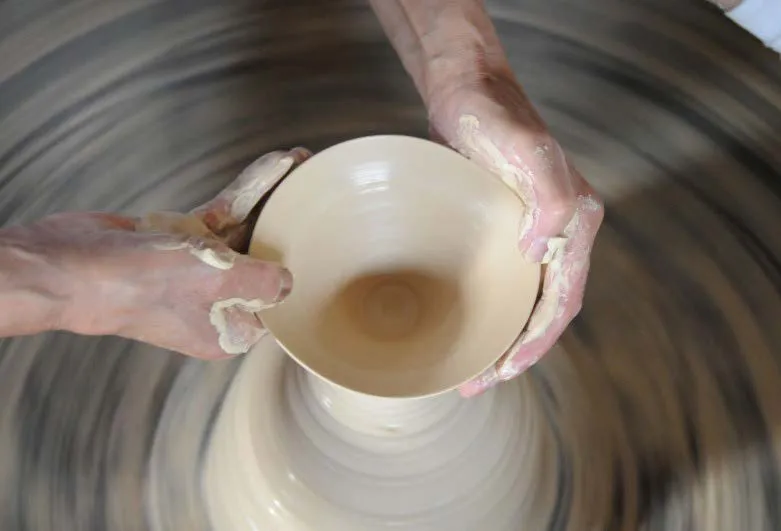
拉坯 石卫明摄Lapi SHI Weiming/photo
As the distribution center for the ceramic industry,Jingdezhen’s porcelain workshop culture has become the most characteristic culture of the ancient town. Since ancient times, the Jingdezhen porcelain workshops have showcased special uniqueness with integrated equipment. The workshop is normally composed of granary, inner courtyard, mud room and central room. The layout of its porcelain making process is also entirely based on the actual needs of hand-made porcelain production. The design of the workshop is very scientific,combining the technological requirements with the climate characteristics of Jingdezhen: facing south provides a long period of sunshine. It benefited from the southeast monsoon and made it possible to make billets on the wooden shelves of the drying racks with the most adequate drying conditions.Below the billet lies a small pond for storing rainwater, and the production water for kneading and muddy materials is taken from the pond. The entire workshop makes full use of the best combination of time and space and natural energy.This unique structure of the blank house could be considered a masterpiece in the architectural culture of China and the world at large.
Magic ceramics smelting
From the end of the Eastern Han Dynasty, Jingdezhen began to burn kiln and make porcelain with firewood, and it has been nearly 2,000 years to date. Jingdezhen porcelain is categorized as a high-temperature porcelain. How can it be burned above 1300 degrees Celsius? But it did burn to 1300 degrees Celsius.Because Jingdezhen’s township kiln is very large with high chimney, which pulls out a fire path in the kiln, resulting in 1300 degrees Celsius in the fire path. The rest is 1,200 degrees Celsius and 1,100 degrees Celsius….. Hence, the location of porcelain in the kiln is very particular. What kind of porcelain bodies, what position should be placed, all must be decided by the kiln master of loading according to the season, climate and their own experience without any instrument measurement and control. The entire huge kiln contains thousands of pieces of porcelain. Its mastery of burning is determined by the experience of the master of Bazhuang with purpose of make the pieces into beautiful porcelain. This magical technology has continued to this day, containing profound and wonderful ceramic cultural connotations.
Unique ceramic packaging
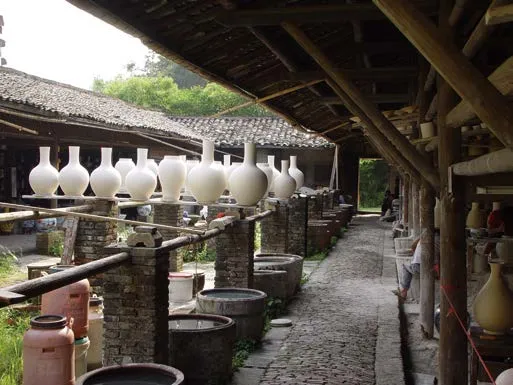
坯房一景A view of rough housing
The packaging culture of Jingdezhen ceramics has been most unique since its history. In order to prevent the damage from the distant transportation, the earliest packaging method of porcelain was called "bean germination packaging". Each piece of porcelain was filled with sand and sprinkled with bean or wheat seeds, and then tied tightly into a bag with a rope. After the seeds germinate, the root buds are entangled together and a solid body is formed, which is ready for loading and shipping. The wisdom and of our ancestors is most evident.Afterwards, with the continuous development of the porcelain industry, the packaging methods are constantly being updated.However, traditional packaging that has lasted for thousands of years is still performed in straws, which can still be found until now. It was depicted in Bamboo Branch of Taoyang: By the goose-neck water bay, barges full of porcelain as hills,porcelain transported by ships, hope men could come back soon. It truly reflects the magnificent scale of ceramic package in ancient Jingdezhen.
Culture of porcelain trading
Distribution is an important part of the ceramic industry, and Jingdezhen ceramics trading culture has its origin here. In ancient and modern times, Jingdezhen porcelain has been traded and disseminated in three ways: shoulder-picking,carrying and shipping. Changjiang, the mother river, passes around the city and goes straight to the Yangtze River, and it assumes almost all the transportation tasks. The spectacular ancient scene "Ceramic workshops open by shores, attracting merchant ships by river" gave birth to the "Changnan Town pottery prevails across nations and distributed overseas",hence, the "silk and porcelain road" on the land and the"ceramics road" by sea have been formed gradually. A porcelain street with profound popularity has been designated in Jingdezhen to promote the free trade of porcelain. The street is paved with bluestone, porcelain shops lined up on both sides crowded with people bargaining for good prices. Porcelain stores and houses have been set up on the porcelain Street. In ancient times, most of the porcelain trade in Jingdezhen was carried out here. There is also the so-called "carrying on sale" style, namely Kaizhou shop. The trading culture of Jingdezhen ceramics has developed along with the advancement of the porcelain production with a rich flavor of this ancient town.
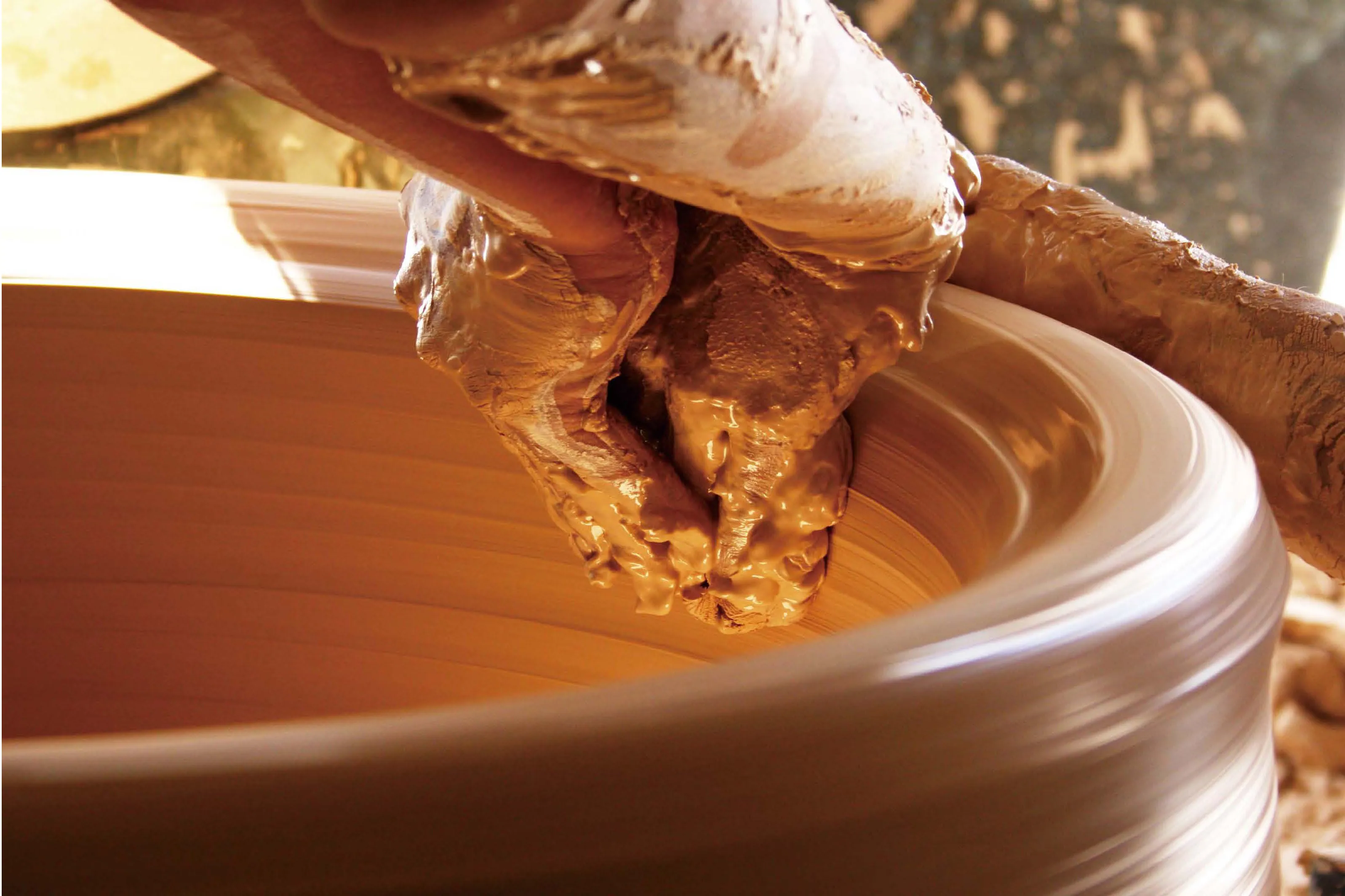
拉坯 陈和平摄Lapi CHEN Heping/photo

“鬼谷下山”大罐(元青花)"Guigu Down Mountain"large jar (Blue and white of Yuan Dynasty)
For thousands of years, Jingdezhen has been telling stories of China through its unique language of porcelain, with the ceramic culture itself evolving and developing constantly. Since the founding of New China, Jingdezhen ceramic art has entered an unprecedented period of prosperity, especially since the reform and opening up. Today's Jingdezhen still retains the most complete traditional handmade porcelain craftsmanship, profound ceramic culture and exquisite ceramic art have attracted numerous artists, who employ the porcelain as their carrier to promote "Chinese value, Chinese folk customs, Chinese Art, Chinese Elements and Chinese Symbols", and have created many porcelain paintings with Chinese ceramics cultural genes and aesthetics spirit. They expressed the ethos and pursuit of the artists with unique ceramic craft language and ceramic painting techniques and formed a new face of Chinese porcelain painting art the new era.
